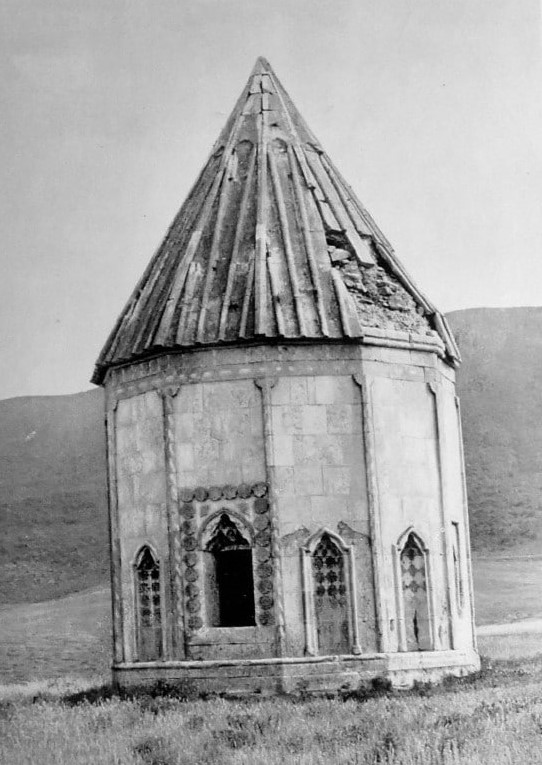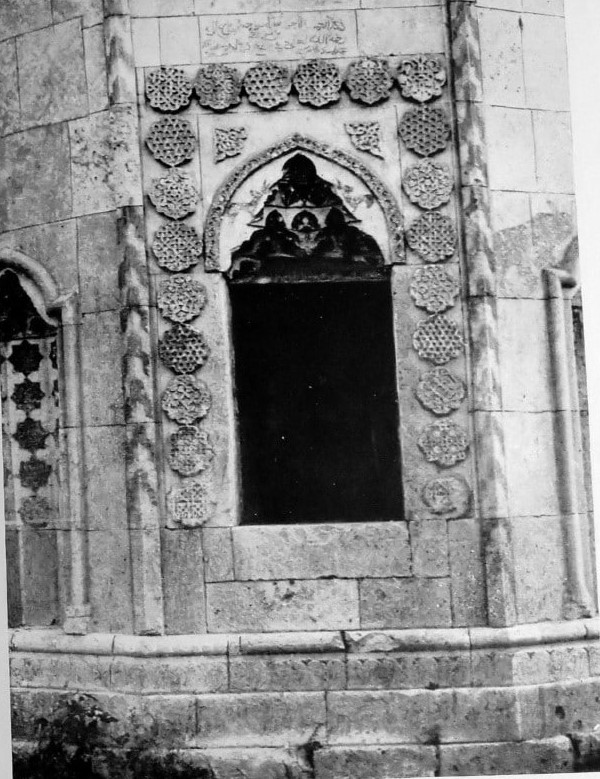Gutlu Musa or Khachin-Dorbatli Mausoleum
The mausoleum of Gutlu Musa or Khachin-Dorbatly is located at a distance of 23 km from the city of Agdam, near the village of Khachindorbatly, Agdam district of Azerbaijan. Among local residents the monument is known as the “Sari Musa” Mausoleum.
[Karabakh: history within the context of the conflict \\ Meshadi Khanum Neymatova. Epigraphic monuments of Karabakh. 2014, p. 153]
 The mausoleum was built on July 15, 1314. This is confirmed by an inscription inserted above the entrance door of the mausoleum:
The mausoleum was built on July 15, 1314. This is confirmed by an inscription inserted above the entrance door of the mausoleum:
“This building (imaret) of departed Gutlu, the son of Musa Khoja, who needs the grace of Allah (God) Almighty. At the beginning (of the month) of Rabiʽ al-Akhir of the year fourteen (and) seven hundred (Monday 15. VII. 1314 A.D.) The work (amal) of the master (ustad) Shahbenzer”.
[M. Useynov L. Bretanitsky. A. Salamzadeh The history of architecture of Azerbaijan. 1963 p. 155]
The names of the buried and the builder are indicated differently in other sources. In the book “Karabakh: history within the context of the conflict” (2014), the name of the buried in the mausoleum is indicated as “Kutlu Khwaja, son of Musa”, and in the book entitled “Azerbaijan. (Historical sightseeings and places of interest”) (1960) – as “Gatava, son of Khoja Musa”. But the name of the one who built the mausoleum in the book written in 2014 and entitled “Karabakh: history within the context of the conflict” is referred to as “Shahbegozar”, and in the book “Art of Azerbaijan of the IV-XVIII centuries” (1976) as “Shakhenzi”.
[Karabakh: history within the context of the conflict \\ Mashadi khanum Neymatova. Epigraphic monuments of Karabakh. 2014, pp. 153-154]
[Azerbaijan. (Historical sightseeings and places of interest). 1960, p. 134]
[L.S. Bretanitsky. B.V. Weimarn. The art of Azerbaijan of the IV-XVIII centuries. 1976, p. 69]

The twelve-sided building of the mausoleum stands on a low three-stage plinth. Its walls have been laid of large limestone resembling marble. The dome of the mausoleum represents by itself a pyramidal tent. Across the top of the dome, stone roofing slabs, shaped and sized like tiles, are laid on a concrete block. On the sides of the mausoleum structure there are openings of elongated size or decorative niches, the top of which is filled with stalactites. Above some parts of the niches and openings there are images of various animals – a predator tormenting a deer, a winged griffin, a bull, a leopard, running deer and roe deer.
According to the architectural forms and images of animals, the architects associated the tomb with the monuments of the Sassanid period (224-651 AD). According to the Soviet historian-orientalist A.Y. Yakubovsky, in the matter of motifs of ornaments, the monument is identical to the Russian Vladimir-Suzdal monuments, (XII-XIII centuries) (Vladimir region, Russia), created by Caucasian masters.
[L.S. Bretanitsky. B.V. Weimarn. The Art of Azerbaijan of the IV-XVIII centuries. 1976, pp. 67;69;71]
[К. M. Mamedzadeh. The construction art of Azerbaijan (from ancient times to the XIX century.) 1983, p. 91]
[Azerbaijan. (Historical sightseeings and places of interest). 1960, p. 134]
[Karabakh: history within the context of the conflict \\ Meshadi Khanum Neymatova. Epigraphic monuments of Karabakh. 2014, p. 153]
The mausoleum has a two-storied structure. The book “The Art of Azerbaijan of the IV-XVIII centuries” in 1976, indicates the following:
“The interior of the mausoleum, as usual, consists of a cruciform crypt and an upper chamber. The rare splendor of the multi-tiered stalactite vault of the chamber is adjacent to the equally complex stalactite compositions of the parts of the cross. The entrance is located in the northern end, and in the southern end there is a finely crafted mihrab with a shell-shaped multi-lobed semi-dome. The mihrab frames a chain of small, elegantly ornamented rosettes.”
[L.S. Bretanitsky. B.V. Weimarn. The art of Azerbaijan of the IV-XVIII centuries. 1976, p. 69]
[M. Useynov L. Bretanitsky. A. Salamzadeh The history of architecture of Azerbaijan. 1963 p. 153]

The entrance aperture of the monument is also framed by a string of large, finely drawn 22 rosettes, reminiscent of the decoration of the entrances of the mausoleum of Melik Azhdar in the Lachin district of Azerbaijan. The mihrab on the southern wall and the content of the Arabic inscription above the entrance doorway of the mausoleum confirm that in the tomb was buried a Muslim.
[L.S. Bretanitsky. B.V. Weimarn. The art of Azerbaijan of the IV-XVIII centuries. 1976, p. 69]
[Azerbaijani Soviet Encyclopedia. Volume X. p. 63]
[General History of Architecture in 12 volumes. Architecture of the countries of the Mediterranean, Africa and Asia. V-XIX century. Volume 8. p 393]
[M. Useynov L. Bretanitsky. A. Salamzadeh The history of architecture of Azerbaijan. 1963 p. 153]
With the occupation of the Aghdam district by Armenian armed forces, in 1993, the mausoleum was vandalized.